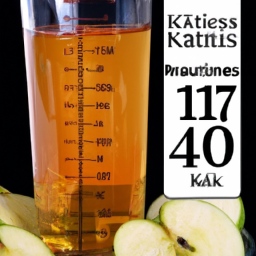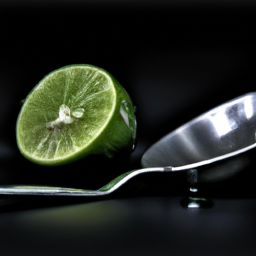Did you know that lime juice can last up to two weeks in the fridge? With proper storage, lime juice can maintain its freshness for a good amount of time. However, it’s important to recognize the signs of spoiled lime juice, as consuming bad juice can lead to food poisoning.
In this article, I will discuss the shelf life of lime juice, how to tell when it has gone bad, and how to extend its shelf life. I will also explore the health benefits of lime juice and provide some delicious recipes for you to try out.
So, if you’re a fan of lime juice, keep reading to learn everything you need to know about its storage and usage.
Key Takeaways
- Lime juice can last up to two weeks in the fridge if stored properly.
- Freshly squeezed lime juice has a shorter shelf life compared to bottled lime juice.
- Bottled lime juice can last for up to six months.
- Frozen lime juice is a great way to extend its shelf life and retain its flavor and nutritional value.
The Shelf Life of Lime Juice
Lime juice’s shelf life can vary depending on factors such as storage temperature, but generally, it lasts for around one to two weeks in the fridge. To maximize its shelf life, it’s important to store lime juice properly. You can store lime juice in a glass or plastic container with a tight-fitting lid. It’s best to use a container that is specifically designed for storing liquids to prevent spills and leaks.
There is a difference between fresh and bottled lime juice when it comes to shelf life. Freshly squeezed lime juice has a shorter shelf life compared to bottled lime juice. Fresh lime juice can last for up to a week in the fridge while bottled lime juice can last for up to six months. However, it’s important to check the expiry date on the bottled lime juice before using it.
Signs that lime juice has gone bad include changes in color, texture, and smell.
Signs that Lime Juice Has Gone Bad
You’ll know it’s time to toss it when the tangy aroma fades and a sour smell takes over, indicating that it’s gone bad.
But before it reaches that point, there are ways to prevent spoilage and extend the shelf life of your lime juice. One way is to make sure the container is tightly sealed to keep air out. Oxygen exposure can cause the juice to spoil faster.
Another way is to store it in the coldest part of the fridge, preferably at 40°F or below. This temperature range slows down bacterial growth and helps preserve the freshness of the juice.
If, however, you find yourself with expired lime juice, don’t throw it away just yet. There are creative uses for it that can still add flavor to your dishes. You can use it as a marinade for meat or seafood, mix it with honey for a homemade salad dressing, or add it to cocktails for a zesty twist.
And if you have more than you can use, can you freeze lime juice? Yes, you can. Find out how in the next section.
Can You Freeze Lime Juice?
So, I’m wondering if I can freeze my leftover lime juice. I hate wasting food, and I have some lime juice that I won’t be able to use before it goes bad.
I want to know if I can freeze it and use it later. If I can, how do I thaw it out?
Freezing Lime Juice
If you’re looking to make your lime juice last longer, go ahead and freeze it! Freezing lime juice is a great way to extend its shelf life and keep its fresh taste for later use.
One of the benefits of freezing lime juice is that it retains its flavor and nutritional value. It’s also a great way to have lime juice on hand for when you need it, without worrying about it going bad.
When it comes to storing frozen lime juice, it’s important to do it properly to avoid freezer burn. One tip is to use an airtight container to prevent air from getting in and causing the juice to oxidize. You can also freeze the lime juice in ice cube trays for easy portioning. Just make sure to label the container or tray with the date, so you know how long it’s been frozen.
Thawing frozen lime juice is easy, and you can do it by placing it in the refrigerator overnight or running it under warm water.
In the next section, we’ll discuss how to use thawed lime juice in your recipes.
Thawing Frozen Lime Juice
When you’re ready to add a zesty kick to your dish, simply thaw your frozen lime juice by placing it in the fridge overnight or running it under warm water. It’s important to note that you should never thaw lime juice at room temperature or in the microwave as it can lead to bacterial growth and spoilage. Once your lime juice is thawed, it’s ready to use in any recipe that calls for fresh lime juice.
Using frozen lime juice can be a convenient way to always have this citrusy ingredient on hand. However, it’s important to remember that frozen lime juice may not have the same flavor or acidity as fresh lime juice. To ensure the best taste in your dishes, it’s recommended to only use frozen lime juice as a last resort. When incorporating frozen lime juice into your recipes, be sure to adjust the measurements as needed to account for any changes in flavor or acidity. Moving forward, let’s explore how to use lime juice in recipes to add a burst of flavor to your meals.
Using Lime Juice in Recipes
I love cooking with lime juice! It adds a zesty, fresh flavor to any dish.
One of my favorite ways to use lime juice in cooking is to make lime-infused marinades for grilled meats.
When it comes to baking, lime juice can be used to add a tartness to desserts like key lime pie or lime bars.
Cooking with Lime Juice
You can add a refreshing zing to your dishes by using lime juice in your cooking, and it lasts for about 2-3 weeks when stored in the fridge. Here are some ways I like to use lime juice in my cooking:
-
Lime juice marinade: Mix lime juice with your favorite herbs and spices to create a marinade for chicken, fish, or tofu. Let the protein soak in the marinade for at least 30 minutes before grilling or baking for a flavorful and juicy dish.
-
Lime juice salad dressing: Whisk together lime juice, olive oil, honey, and Dijon mustard for a tangy and sweet salad dressing. Toss with mixed greens and your favorite veggies for a refreshing and healthy meal.
-
Lime juice in guacamole: Mash ripe avocados with lime juice, diced tomatoes, red onion, and cilantro for a delicious and creamy guacamole.
-
Lime juice in ceviche: Combine diced raw fish, shrimp, or scallops with lime juice, diced onion, jalapeno, and cilantro for a fresh and citrusy ceviche.
-
Lime juice in salsa: Mix diced tomatoes, red onion, jalapeno, cilantro, and lime juice for a zesty and flavorful salsa.
Using lime juice in baking can also add a unique twist to your desserts. Let’s explore this in the next section.
Baking with Lime Juice
Adding a splash of lime juice to your baked goods can elevate the flavor profile and give them a tropical twist. Lime juice is a versatile ingredient that can be used in a variety of baked goods, from cakes and cookies to pies and tarts. It adds a tangy, citrusy flavor that pairs well with sweet desserts.
If you don’t have fresh lime juice on hand, you can use bottled lime juice or lime juice concentrate as a substitute. However, keep in mind that the flavor may not be as bright and fresh as using fresh lime juice.
Lime juice can also be used in cocktails to add a refreshing twist. It pairs well with tequila in a classic margarita or with rum in a mojito. When using lime juice in cocktails, it’s important to use fresh lime juice for the best flavor.
Bottled lime juice or lime juice concentrate may have added preservatives or artificial flavors that can affect the taste of the cocktail.
Now that we’ve covered baking and cocktails, let’s explore some alternative uses for lime juice.
Alternative Uses for Lime Juice
I’d like to discuss some alternative uses for lime juice that you may not have considered before.
Firstly, did you know that lime juice can be an effective cleaning agent? Its acidity makes it great for removing stains and disinfecting surfaces.
Secondly, lime juice can also be used in your beauty routine. Its high vitamin C content can help brighten and even out skin tone, while its natural oils can moisturize and nourish hair.
Cleaning with Lime Juice
Using lime juice as a cleaning agent can be a natural and effective way to remove stains and disinfect surfaces. Lime juice contains citric acid, which has antibacterial properties that can help kill germs and bacteria. It can also act as a natural bleach, making it a great solution for removing tough stains from fabric and surfaces.
To use lime juice as a natural disinfectant, mix equal parts lime juice and water in a spray bottle. Shake well and spray onto surfaces that need to be cleaned and disinfected. Let it sit for a few minutes before wiping clean with a damp cloth. For tougher stains, apply the solution directly onto the stain and let it sit for a few minutes before washing as usual.
Moving onto the subsequent section about ‘beauty uses for lime juice’, it’s important to note that lime juice can also be used as a beauty product. From brightening skin to treating dandruff, the possibilities are endless.
Beauty Uses for Lime Juice
Transform your beauty routine with lime juice. This versatile ingredient can do wonders for your skin, hair, and nails. By incorporating lime juice into your DIY skincare routine, you can achieve a brighter, clearer complexion.
Lime juice contains high levels of vitamin C, which is essential for collagen production and helps to reduce the appearance of fine lines and wrinkles. Additionally, lime juice has natural exfoliating properties that can help to remove dead skin cells and unclog pores.
Incorporating lime juice into your haircare routine can also have numerous benefits. Lime juice has astringent properties that can help to remove excess oil from the scalp, promoting healthy hair growth. It can also be used as a natural hair lightener, providing a gentle alternative to harsh chemical treatments. Lime juice can also help to smooth and soften hair strands, making it a great natural conditioner.
So, why not give lime juice a try in your next beauty DIY project and see the difference it can make for your skin, hair, and nails?
To extend the shelf life of lime juice, there are a few simple steps you can take. One option is to freeze the juice in ice cube trays, making it easy to defrost small amounts as needed. Another option is to preserve the juice with citric acid or vinegar, which can help to inhibit bacterial growth. By taking these precautions, you can ensure that your lime juice lasts as long as possible, allowing you to continue to enjoy its many benefits.
How to Extend the Shelf Life of Lime Juice
As I’ve mentioned before, lime juice has a relatively short shelf life once opened. However, there are some methods you can use to extend its lifespan.
One way is to add preservatives such as sodium benzoate or potassium sorbate to the juice. Another option is to use citric acid, which can help to increase the acidity level of the juice and prevent the growth of harmful bacteria.
With these techniques, you can ensure that your lime juice stays fresh for longer.
Adding Preservatives
To extend the shelf life of your lime juice, you should consider adding preservatives like citric acid or sodium benzoate. Preservatives are necessary to prevent the growth of bacteria and fungi, which can cause spoilage and make the juice unsafe to consume. However, it is important to note that not all preservatives are created equal. Some are more effective than others, and some may have negative health effects when consumed in large amounts.
Preservative options for lime juice include both natural alternatives and synthetic chemicals. The table below provides a comparison of the most commonly used preservatives for lime juice, along with their pros and cons. As you can see, citric acid is a natural preservative that is safe and effective when used in small amounts. In the next section, we will discuss how to use citric acid to extend the shelf life of your lime juice.
| Preservative | Pros | Cons |
|---|---|---|
| Citric Acid | Natural, safe, effective | May affect flavor |
| Sodium Benzoate | Synthetic, effective | May cause allergic reactions |
| Potassium Sorbate | Synthetic, effective | May cause digestive issues |
Using citric acid is a simple and effective way to extend the shelf life of your lime juice. By adding just a small amount of citric acid to your juice, you can prevent the growth of bacteria and fungi and keep your juice fresh for longer. In the next section, we will provide step-by-step instructions for using citric acid to preserve your lime juice.
Using Citric Acid
Let’s learn how to utilize citric acid to prolong the potency of your lime juice. Using citric acid for preservation is a fantastic way to keep your lime juice fresh and flavorful for longer periods. Citric acid is a natural preservative that helps inhibit the growth of bacteria, mold, and yeast in your lime juice. It also helps maintain the pH level of the juice, which further slows down the spoilage process.
One of the benefits of using lime juice in marinades is that it adds a tangy flavor to the dish. However, lime juice can quickly lose its potency if not adequately preserved. Adding citric acid to your lime juice helps it last longer and retain its flavor. By doing so, you can enjoy the benefits of using lime juice in your cooking without worrying about it going bad too soon.
Now, let’s move on to the health benefits of lime juice.
The Health Benefits of Lime Juice
Lime juice is a zesty addition to any dish and can provide a burst of citrus flavor and health benefits. Consuming lime juice regularly can provide a range of health benefits, including aiding digestion, boosting the immune system, and promoting healthy skin.
Lime juice is also known for its natural remedy properties. It can help relieve constipation, reduce inflammation, and even prevent certain types of cancer. Additionally, lime juice is a great source of vitamin C, which is essential for maintaining a healthy body.
Overall, incorporating lime juice into your diet can have numerous benefits for your overall health and well-being. When it comes to buying lime juice, it’s important to choose the right type. Look for 100% pure lime juice that has no added sugars or preservatives.
Freshly squeezed lime juice is also a great option, as it contains all the natural nutrients and benefits of the fruit. By choosing the best type of lime juice, you can ensure that you’re getting the most out of this delicious and nutritious citrus fruit.
Best Types of Lime Juice to Buy
Choosing the right type of lime juice can make all the difference in reaping the health benefits and avoiding added sugars or preservatives. When it comes to purchasing lime juice, it’s important to read the labels and opt for those that are made with 100% lime juice and no added sugars or preservatives. Avoid products that contain high fructose corn syrup, artificial flavors, or other additives that can diminish the nutritional value of the juice.
In addition to reading labels, consider using freshly squeezed lime juice in recipes. Not only does this provide a more authentic and flavorful taste, but it also contains more nutrients than processed juice. Freshly squeezed lime juice is rich in vitamin C, antioxidants, and other beneficial compounds that can support immune function, improve digestion, and even aid in weight loss. With the right type of lime juice and some creative recipe ideas, you can easily incorporate this nutritious ingredient into your meals.
Lime Juice Recipes
You may think that using lime juice in recipes is limited to cocktails and marinades, but there are actually a variety of delicious and nutritious dishes you can create.
Lime juice adds a tangy flavor to salads, soups, and even desserts. For example, you can use lime juice to make a refreshing and healthy salad dressing by mixing it with olive oil, honey, and Dijon mustard. Or, you can add a splash of lime juice to your soup to enhance its flavor and give it a zesty kick.
Lime juice cocktails are also a popular use for this versatile citrus fruit. From classic margaritas to mojitos, the possibilities are endless. You can also experiment with different ingredients to create your own unique lime juice cocktails.
Lime juice marinades are another great way to add flavor to your dishes. Simply mix lime juice with your favorite spices and herbs, and marinate your meat for a few hours before cooking. This will not only add flavor, but also tenderize the meat and make it more succulent.
So next time you’re in the kitchen, don’t forget about the many ways you can use lime juice to enhance your dishes.
Frequently Asked Questions
Is it safe to consume lime juice past its expiry date?
Consuming expired lime juice may lead to foodborne illness. Instead, try using vinegar or other citrus juices in cooking or baking. Expired lime juice can still be used for cleaning or as a natural beauty remedy.
Can you mix lime juice with other liquids to extend its shelf life?
Can lime juice be mixed with other liquids to extend its shelf life? Yes, adding citric acid or refrigerating can preserve lime juice. Using lime juice in cocktails adds a tart flavor and aids in digestion.
How do you know if lime juice has gone bad if it doesn’t have a strong smell?
To determine if lime juice has gone bad, look for signs of mold or discoloration. If it doesn’t have a strong smell, it may still be safe to use but won’t be as flavorful. To make lime juice last longer in recipes, mix it with other acidic ingredients or store it in an airtight container in the fridge. If it’s expired, consider using it for non-food purposes like cleaning or skincare.
What are some common mistakes people make when storing lime juice?
Storing lime juice can be tricky. Common mistakes like using incorrect containers, leaving it in warm places, or forgetting to seal it properly can lead to spoilage. Best practices include using airtight containers, refrigerating immediately, and using within a week.
Are there any health risks associated with consuming expired or spoiled lime juice?
Consuming expired or spoiled lime juice can lead to potential hazards such as food poisoning, upset stomach, and effects on digestion. Allergic reactions are also possible. Proper disposal is necessary to avoid these risks.
Conclusion
In conclusion, knowing how long lime juice lasts in the fridge can save you from consuming a sour and unappetizing drink. It can last up to two weeks, but it’s crucial to pay attention to signs of spoilage, such as an off smell or taste.
Freezing lime juice is an option, but it can compromise the quality of the juice. Despite its short shelf life, lime juice is a versatile ingredient that can be used in various recipes and even for household cleaning.
By following proper storage techniques and purchasing high-quality lime juice, you can extend its shelf life. With its numerous health benefits and refreshing taste, lime juice is a must-have in any kitchen.
Ilana has been a vegan for over 10 years. She originally made the switch for health reasons, but soon found herself becoming more and more passionate about the ethical and environmental implications of a vegan lifestyle. Ilana is the author of The Graceful Kitchen, a blog all about veganism. She loves to cook up delicious and nutritious vegan meals, and share her recipes with others who are interested in leading a cruelty-free life. Ilana is also a strong advocate for using whole foods as the foundation of a healthy diet, and believes that going vegan is one of the best ways to achieve this.










